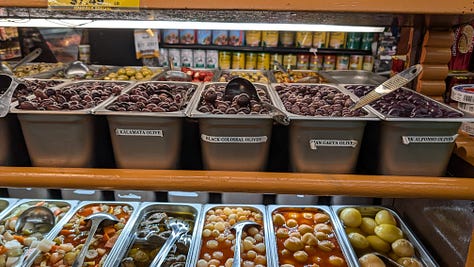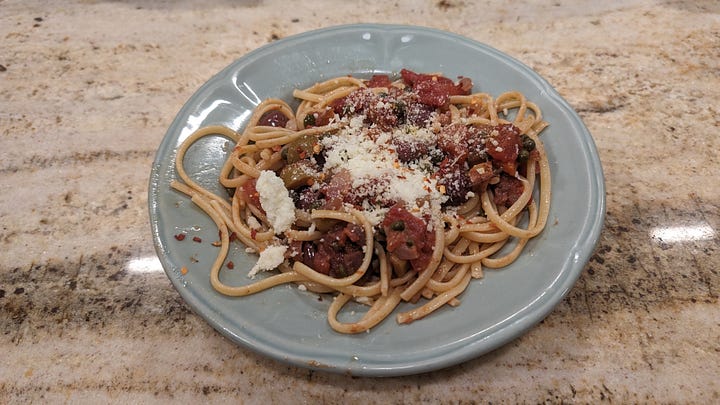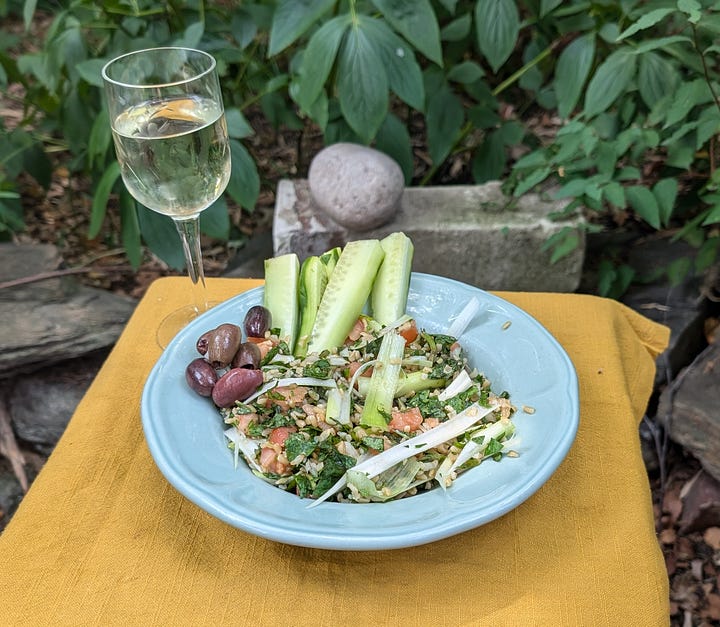Hanging Out with My New Companion
A kitchen gathering
Nancy Harmon Jenkins has become a dear presence in my life ever since we discovered each other’s newsletter. She’s one of the few writers I’ve found whose stories and recipes are equally enticing. Read just one of them at On the Kitchen Porch and you’ll agree. She is an accalimed author of several books about Mediterranean food—and the truly facinating The Boat Beneath the Pryramid. I’ve cooked many dishes from the regions but since I have acquired her updated and reissued classic, The New Mediterranen Diet Cookbook, a Delicious Alternative for Lifelong Health, they are more vibrant and interesting. Suddenly family and friends believe they have a right to follow their noses into my kitchen and take a huge forkful while the dishes cook.
One of the great blessings in my life is to live in a neighborhood settled by people from countries bordering the Mediterranen Sea. Our main street is lined with small family stores and food markets where I do almost all my shopping. But that



doesn’t mean I always have a clue about what to do with my purchases. Now I do. Nancy writes about their history and describes why their flavors and textures are so important. Their use in a recipe are cleanly written, the whole full of good advice. The pages in my copy are already stained and dog-eared.
You simply cannot ask anymore from a cookbook.
. . . Mediterranean people are on the whole conscious of food in a way that most people, certainly most Americans, are not. . . . .Rather, it seems to me that in the countries of the Mediterranean there exits a deep-seated and largely unspoken consensus that eating is one of the most important things we humans do in our lives, As a great anthropologists once told me, it is our single most intimate act, far more intimate than sex because through food we literally re-create ourselves each and every day of our lives. — Nancy Harmon Jenkins The New Mediterranen Diet Cookbook, a Delicious Alternative for Lifelong Health
The one difficulty I’ve encountered with the recipes is their generous serving sizes. Most nights, I’m only cooking for my husband and I which means I have to do math to cut them down to size. (I’m completely math illiterate.) But the flavors of the dishes only grow richer by the next day and leftovers for lunch have suddenly become something we look forward to.
My week of cooking with Nancy resulted in a huge amount of tabbouleh, spaghetti puttanesca, Moroccan chicken with preserved lemons and olives, North African shrimp tagine, and two clafoutis—one made with plums, the other with apricots because the cherries that are traditionally used were not at their best in the market.
If you don’t have a store where you can pick up the recipes’ ingredients, Nancy has provided a list of sites where you may purchase them on-line.




I’ve asked Nancy if I could reprint the recipe for the shrimp tagine. It was a tough choice to make but it was the one that I had to most smack my husband’s hand from eating more than his fair share. Nancy explains that tagine refers to both a type of dish and a cooking pot. You can use any pot for this recipe but it’s also a great excuse to purchase a tagine. Like cast iron, the clay needs to be seasoned first. Like my cast iron skillets and pots, no one but me is allowed to wash my tagine. This is the reason why mine looks a little scruffy, which is how it should be.
The perfection of summer’s fruits and vegetables coming into the market, the flavorful dishes they create accompanied by their customary glass of wine and served outside protected in the shade of a sultry day, pratically demands the dishes from the Mediterranean. And now we have Nancy to help us compose such a pleasing fantasy.
Thank you, my friend!
North African Shrimp Tagine
Makes 4 to 6 servings
Don’t be put off by the length of the ingredients and instructions. Most of the ingredients are readily available and the recipe comes together very quickly. I’ve put in paratheses my small adjustments mainly because I forgot an ingredient or two.
1/2 cup finely minced flat-leaf parsley 1/2 cup finely minced cilantro 1 tablespoon finely minced fresh ginger 1 tablespoon medium-hot Spanish pimentón (paprika) or other ground red chili pepper, such as piment d'Espelette or Aleppo pepper a big pinch of saffron 1/3 cup extra-virgin olive oil freshly squeezed juice of 1 lemon 1 1/2 pounds medium shrimp, peeled, tails left on (I removed the tails because they freak out my husband.) 8 fresh ripe plum tomatoes, peeled and chopped, or use 8 drained canned tomatoes, chopped, juice reserved. ( It was already late in the evening so I used canned because it would have taken forever to prepare the very lovely 8 fresh tomatoes I had purchased--I'll do that next time.) 2 fat garlic cloves, minced 1 teaspoon ground cumin sea salt and freshly ground pepper 3 medium carrots, peeled and sliced diagonally 1 large or 2 medium sweet red onions, halved and sliced longitudinally 4 medium red potatoes, partially peeled, sliced (I forgot to buy red so I used the white ones I had on hand.) 1 sweet red or yellow pepper, very thinly sliced 1 medium-hot green pepper, very thinly sliced (I regret to report that I omitted this because my stomach was acting up. The added flavor and heat was missed.) 1 whole salt-presereved lemon, thinly sliced (Nancy has a very easy recipe for making you're own.) 1/2 cup green or black olives, pitted (You're going to use a lot of olives in Mediterranean recipes so go ahead and buy a shelf of different varities and from different countries. Snacking on them throughout the day is also highly recommended.)
Combine the parsley, cilantro, ginger, pimentón, saffron, olive oil, and lemon juice in a bowl. Pick over the shrimp and rinse briefly under running water. Add the shrimp to the bowl, stirring to mix well. Set aside to marinate for no longer than 30 minutes. The shrimp become mushy if marinaded for too long.
Meanwhile, combine the chopped tomatoes with the garlic and cumin in a sauce pan and bring to a simmer. Cook, uncovered, over medium heat for 20 to 30 minutes or until the tomato sauce is thick, adding juice from the can or a little water from time to time to keep the sauce from scorching. When the sauce is thick, add a little salt and plenty of black pepper.
Spread about 3/4 cup of the tomato sauce in the bottom of a tagine or other cooking pot, then layer the carrots over the sauce, Sprinkle the onion slices over the carrots, then layer the potato slices on top. Finally distribute the pepper slices over the potatoes and spoon the remaining tomato sauce on top. Cover the pot, set it over medium-low heat, and cook the vegetables until they are tender, 20 to 30 minutes. From time to time, if necessary, add a little water, or juice from the canned tomatoes, to the pan to keep it from scorching.
When the vegetables are tender, layer the marinated shrimp on top of the tagine. Add the slives of salted lemon and olives, then pour anything left of the marinade over the top. Cover the tagine once again and cook until the shrimp is done—about 10 minutres,
Check the sauce and if it is very thin and soupy, remove the cooked shrimp and set aside in a warm place. Raise the heat under the tagine and cook rapidly until the sauce thickens, then return the shrimp and serve in the tagine, sprinkling a little freshly chopped cilantro over the top if you wish.




Oh, Pat, of course i loved this and i have to thank you a thousand times over for such a ringing tribute. I am glowing! I will write more when i rescue my computer from the ER where it’s being restored to life but for now it’s just: Thank you!
Wonderful post! Thanks! I admit I bought a Moroccan tagine years ago on sale—it was beautiful and I used it as decor and never cooked in it. Now maybe I’ll put it to use. Looks like a great recipe!